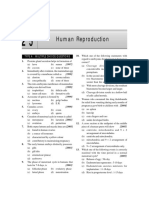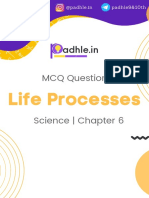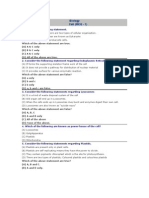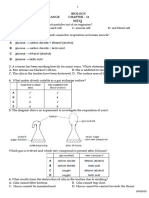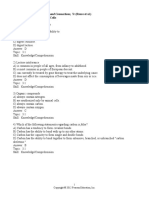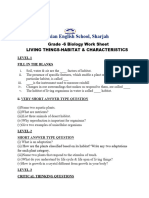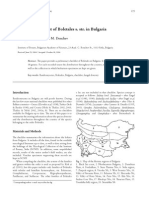100%(2)100% found this document useful (2 votes)
6K viewsMCQs of Plant Transportation
MCQs of Plant Transportation
Uploaded by
professor zulfi1. The main advantage of hydroponics in nutrient research is that nutrient measurements can be made accurately because in a liquid solution they are not isolated in soil a few millimeters away from a root hair.
2. The document provides a 35 question multiple choice quiz on plant transportation and nutrition.
3. The questions cover topics like soil composition and properties, mineral uptake, transpiration, translocation via xylem and phloem, guttation, and adaptations of plant roots.
Copyright:
Attribution Non-Commercial (BY-NC)
Available Formats
Download as DOCX, PDF, TXT or read online from Scribd
MCQs of Plant Transportation
MCQs of Plant Transportation
Uploaded by
professor zulfi100%(2)100% found this document useful (2 votes)
6K views5 pages1. The main advantage of hydroponics in nutrient research is that nutrient measurements can be made accurately because in a liquid solution they are not isolated in soil a few millimeters away from a root hair.
2. The document provides a 35 question multiple choice quiz on plant transportation and nutrition.
3. The questions cover topics like soil composition and properties, mineral uptake, transpiration, translocation via xylem and phloem, guttation, and adaptations of plant roots.
Copyright
© Attribution Non-Commercial (BY-NC)
Available Formats
DOCX, PDF, TXT or read online from Scribd
Share this document
Did you find this document useful?
Is this content inappropriate?
1. The main advantage of hydroponics in nutrient research is that nutrient measurements can be made accurately because in a liquid solution they are not isolated in soil a few millimeters away from a root hair.
2. The document provides a 35 question multiple choice quiz on plant transportation and nutrition.
3. The questions cover topics like soil composition and properties, mineral uptake, transpiration, translocation via xylem and phloem, guttation, and adaptations of plant roots.
Copyright:
Attribution Non-Commercial (BY-NC)
Available Formats
Download as DOCX, PDF, TXT or read online from Scribd
Download as docx, pdf, or txt
100%(2)100% found this document useful (2 votes)
6K views5 pagesMCQs of Plant Transportation
MCQs of Plant Transportation
Uploaded by
professor zulfi1. The main advantage of hydroponics in nutrient research is that nutrient measurements can be made accurately because in a liquid solution they are not isolated in soil a few millimeters away from a root hair.
2. The document provides a 35 question multiple choice quiz on plant transportation and nutrition.
3. The questions cover topics like soil composition and properties, mineral uptake, transpiration, translocation via xylem and phloem, guttation, and adaptations of plant roots.
Copyright:
Attribution Non-Commercial (BY-NC)
Available Formats
Download as DOCX, PDF, TXT or read online from Scribd
Download as docx, pdf, or txt
You are on page 1of 5
At a glance
Powered by AI
The passage discusses the components of soil, transport of water and nutrients in plants, and the processes of photosynthesis and transpiration.
The main components that make up soil are mixtures of particles in different sizes, living organisms, decaying organic material, air, and water.
Main adaptations that allow plants to transport water and nutrients include root structures, vascular tissues like xylem and phloem, processes like transpiration and cohesion-tension, and symbiotic relationships with fungi and bacteria.
MCQs OF Plant Transportation
NUTRITION AND TRANSPORT IN PLANTS QUIZ
NAME: ____________________________________________
_____1. The main advantage of hydroponics in nutrient research is that
a) it excludes hydrogen ions.
b) it is simply a "cleaner" experimental system without any "dirt" involved.
c) in water, the plant does not need and other molecules beyond carbon dioxide.
d) plant growth can be maximized since the minimal supply of water is never a problem.
e) nutrient measurements can be made accurately because in a liquid solution they are not isolated in soil
a few millimeters away from a root hair.
_____2. Which element is Not one of the three most common ones in plants?
a) oxygen b) sulfur c) carbon d) hydrogen
_____3. Which statement is Not true about mineral availability?
a) Acidic water leaches minerals from the soil zone where plants can absorb them.
b) Toxic iron and aluminum levels may by produced in highly basic soil.
c) Clay and organic materials attract positively charged ions in a soil.
d) Roots must be within a few millimeters of minerals to be able to absorb them.
_____4. Soil formation is due to
a) decomposition of organic matter.
b) weathering or transport of bedrock.
c) activity of animals such as earthworms.
d) All of the above change the nature of soil.
_____5. Soil consists of
a) a mixture of soil particles of different sizes.
b) both living organisms and decaying organic material.
c) air.
d) All of these are components that define soil.
_____6. Which is an Incorrect association of soil particles and characteristics?
a) Sand - largest size, cannot hold water.
b) Clay - medium size, intermediate properties.
c) Loam - medium size, retains water and nutrients and allows drainage.
d) Silt - medium size, intermediate properties.
_____7. Which is a Correct relationship between soil particles and leaching of soil ions?
a) Clay particles hold tight to NO3- and the nitrogen content of clay soils is therefore high.
b) Clay is unable to retain Ca2+ and K+ which are easily leached away.
c) Clay holds water and clumps.
d) Sand prevents water erosion and leaching.
_____8. Which is an Incorrect description of the layers in soil?
a) The C horizon is newly weathered bedrock.
b) The B horizon contains the soluble chemicals leached from the A horizon.
c) The A horizon is the rich topsoil and contains all the humus and soluble chemicals.
d) Earthworms and leaf litter are most prevalent in the A horizon.
e) The A horizon is more shallow in forests than in grasslands.
_____9. The degree of erosion is best described as
a) there is a set amount of soil that was originally formed and erosion continually removes some of it, therefore
we will one day run out of topsoil due to erosion.
b) Soil forms at generally the same rate as soil erodes, so there is an overall balance just as worldwide precipitation
equals evaporation; it is just not evenly spread across the landscape.
c) soil is eroding faster than it is being formed on about one-third of all cropland.
d) removal of trees helps build up topsoil and prevent erosion.
_____10. The plasma membrane of plant cells
a) actively transport water into the cell.
b) allows the entry of all minerals equally.
c) actively transports some mineral ions into the cell.
d) concentrates minerals up to 100 times as much as in the soil.
_____11. Which statement is Not true about root adaptations in plants?
a) Some plants have a very poorly developed roots or none at all.
b) Fungal mycorrhizae depend on plants for the fungus's supply of water and minerals.
c) Some plants, including orchids, require the presence of fungal symbionts to survive.
d) Parasitic plants have root adaptations called haustoria that draw nutrients from the host.
e) Bacteria of the genus Rhizobium live in root nodules in legumes, producing available nitrogen that the plant uses.
_____12. Girdling is a process by which
a) plants carry water upward.
b) plants carry nutrients upward.
c) plants carry nutrients downward.
d) a tree is killed by interrupting the passage of phloem sap.
e) a tree is killed by interrupting the passage of xylem sap.
_____13. An epiphyte is a plant that
a) is not able to carry out photosynthesis.
b) does not have roots but absorbs nutrients from the air.
c) has a relationship with mycorrhizal fungi on its roots.
d) has a relationship with nitrogen-fixing bacteria on its roots.
_____14. Which statement is Not true about water uptake in a plant root?
a) Water enters the root by osmosis from the soil.
b) Water enters the cytoplasm of the root hairs by active transport.
c) Water travels by diffusion through the cell walls of the epidermis and cortex.
d) Water must enter the cytoplasm of the endodermal cells to get past the Casparian strip.
_____15. Which of these is most likely to be produced by the plant in usable amounts?
a) minerals b) water c) oxygen d) carbon dioxide
_____16. Which statement is Not true about water availability in soil?
a) Sand has smaller soil pores than those of clay.
b) The field capacity is the water remaining in soil after drainage.
c) The field capacity of sand is lower than that of clay.
d) Available water is that which can be taken up from the soil by plant roots.
_____17. The point at which water present in the soil is not available to roots because it is too tightly held by
soil particles is called the ____ point.
a) permanent wilting
b) field capacity
c) available water
d) unavailable water
e) water failure
_____18. If you cut a herbaceous stem and observe fluids continually seeping upward and out of the cut, it is most
likely to be due to
a) root pressure
b) turgor pressure
c) active transport by phloem
d) tension caused by transpiration
e) cohesion to the xylem walls
_____19. Because most roots need gaseous oxygen as well as liquid water, the best soil for agricultural plants is
a) sand, since it has the greatest pore spaces.
b) clay, since it holds onto water better than silt or sand.
c) silt, because it is intermediate between sand and clay in size.
d) loam, a mixture of all size soil particles and therefore able to hold onto water but be porous.
e) All sizes of soil particles (sand, silt, clay) are equal in soil properties.
_____20. When you have waxed your car, rainfall makes very large droplets that roll around on the hood.
This property of the water molecule is known as
a) adhesion b) turgor pressure c) cohesion d) transpiration e) negative pressure potential
_____21. Most minerals move into the xylem of the root's vascular cylinder from the endoderm by
a) active transport
b) osmosis
c) movement against a concentration gradient
d) movement down a concentration gradient
_____22. Which term describes forcing water out of the plant at the edges of its leaves?
a) water stress b) atmospheric pressure c) root pressure d) guttation e) transpiration
_____23. Which force is responsible for moving water up to the tops of the tallest trees?
a) water stress b) atmospheric pressure c) root pressure d) guttation e) transpiration
_____24.Which force pushes water into the xylem as osmosis moves water into the root?
a) water stress b) atmospheric pressure c) root pressure d) guttation e) transpiration
_____25. Which force is the central causative agent of the cohesion-tension model of xylem transport?
a) water stress b) atmospheric pressure c) root pressure d) guttation e) transpiration
_____26. Which statement is Not true about stomates?
a) As guard cells become turgid, the stomates open.
b) There are two guard cells around each stomate.
c) Guard cells take up potassium ions and water enters the guard cells.
d) Guard cells surrounding stomates lack chloroplasts that other epidermal cells contain.
e) Stomates open and close on a daily basis, even if kept in the dark, on a circadian rhythm.
_____27. The main component of phloem is
a) hormones b) amino acids c) sucrose d) glucose e) lipids
_____28. Which statement is Not true about the pressure-flow model of phloem transport?
a) Water is actively transported into phloem.
b) Phloem sap moves at a rate of 60 to 300 cm per hour.
c) Pressure is created in the phloem by the buildup of water and sugar.
d) Sugar produced by photosynthesis is actively transported into the phloem cells.
e) Sugar is actively transported out of the phloem at the sink area such as the root.
_____29. To secure genuine maple syrup, maple tree trunks are "tapped" with metal spigots that interrupt the
flow of sap in late winter prior to spring budding. Which of the following would be true of this process?
a) Leaves are the ultimate origin of the sucrose component.
b) The sap flows out with some pressure from the phloem tube.
c) The water component originated from soil water absorbed by root hairs.
d) Only a small core is tapped; taking sap continuously from a substantial radius could
eventually kill part of the tree.
e) All of the above are correct.
_____30. The loss of water by the leaves and stem of a plant is called
a) translocation b) osmosis c) active transport d) transpiration
_____31. The transport of sugar from the leaf to the rest of the plant is called
a) translocation b) osmosis c) active transport d) transpiration
_____32. The driving force for transpiration is provided by
a) water pressure in the roots
b) water tension in the stems
c) the evaporation of water from the leaves
d) the hydrolysis of ATP
_____33. What causes water molecules to stick together and pull each other up a plant stem?
a) adhesion b) cohesion c) phloem d) companion cells
_____34. This hormone is known for assisting in the closing of the stomata, and inhibition of cell growth
a) abscisic acid b) auxin c) cytokinin d) ethylene e) gibberellin
_____35. Guttation is the loss of water through the
a) stomata
b) cells at the ends of veins in leaves
c) root hairs
d) weak spots in the Casparian strip
e) vascular cambium
_____36. The process of cohesion is responsible for
a) leaves pulling water up from their roots.
b) the diffusion of water through a semipermeable membrane.
c) the stability of temperature of organisms.
d) lakes not freezing from the top down.
e) cooling of body surfaces during evaporation.
_____37. A leafy plant experiences a heavy rainfall. Several hours latter, you notice an increase in turgidity
of the plant's leaves. Which of the following is primarily responsible for this?
a) capillary action b) osmosis c) transpiration d) root pressure e) respiration
_____38. Which of the following statements is not true concerning the cohesion-tension theory of water movement
in plants?
a) Adhesion accounts for the attraction between water molecules.
b) Cohesion accounts for the attraction between water and the vessel walls.
c) Root pressure is a significant force in driving water up a stem.
d) Companion cells help xylem regulate the passage of water and minerals.
e) All of the above are not true.
_____39. Which of the following is Most responsible for the movement of water up a tall tree?
a) adhesion b) capillary action c) guttation d) osmosis e) sun light
_____40. The driving force for the movement of materials in the phloem of plants is
a) gravity
b) a difference in osmotic potential between the source and sink
c) root pressure
d) transpiration of water through the stomates
e) adhesion of water to vessel elements
_____41. The rate of flow of water through the xylem is regulated by
a) passive transport by the pith
b) the force of transpirational pull
c) the number of companion cells in the phloem
d) active transport by the sieve-tube members
e) active transport by tracheids and vessel elements
_____42. Aphids are insects that insert their needle like mouth parts into plants. Sometimes, fluid from the plant
tissues passes entirely through the digestive track of the aphid and emerges as a small droplet at it posterior end.
The source of this liquid is probably
a) epidermal cells b) phloem cells c) tracheids d) vessels e) xylem cells
You might also like
- Hosa Practice Questions 1Document12 pagesHosa Practice Questions 1rohitmital0% (1)
- The Aku Recreated Exam 2021 With KeyDocument14 pagesThe Aku Recreated Exam 2021 With Keyuswa anwerNo ratings yet
- Biology Grade 11 Mock Exam Paper 1Document7 pagesBiology Grade 11 Mock Exam Paper 1Nicketa AndersonNo ratings yet
- Biology Work Sheet For Grade 10 PDFDocument7 pagesBiology Work Sheet For Grade 10 PDFYishakNo ratings yet
- Multiple Choice Questions (MCQ) Topic Quiz Cell Division, Cell Diversity and Cellular OrganisationDocument20 pagesMultiple Choice Questions (MCQ) Topic Quiz Cell Division, Cell Diversity and Cellular OrganisationyunnNo ratings yet
- Question Bank On PhotosynthesisDocument11 pagesQuestion Bank On PhotosynthesisSachin Kothari100% (1)
- Animal Kingdom-Mcq-DownloadDocument2 pagesAnimal Kingdom-Mcq-DownloadPavani SunuNo ratings yet
- CBSE 8, Science, CBSE - Cell Structure and Functions, MCQDocument3 pagesCBSE 8, Science, CBSE - Cell Structure and Functions, MCQR.Shruti 1040-12No ratings yet
- L-9 The Excretory System: A. Multiple Choice TypeDocument6 pagesL-9 The Excretory System: A. Multiple Choice TypeNeha ChandelNo ratings yet
- M.C.Q'S (Diffusion)Document2 pagesM.C.Q'S (Diffusion)Areeb50% (2)
- 25 MARKS - SENSE ORGANS-Multiple Choice AssessmentDocument2 pages25 MARKS - SENSE ORGANS-Multiple Choice Assessmentdharsanie rampersaud100% (1)
- Life Process - Biology MCQDocument3 pagesLife Process - Biology MCQJASMINE VIDHYANo ratings yet
- 5th Grade Quiz Week 3Document3 pages5th Grade Quiz Week 3api-254428474No ratings yet
- 1.8.1 Bacteria Virus Fungi Questions and AnswersDocument17 pages1.8.1 Bacteria Virus Fungi Questions and AnswersattueNo ratings yet
- Part - I (MCQ) (Compulsory)Document4 pagesPart - I (MCQ) (Compulsory)Tehzeeb ZubairiNo ratings yet
- Class 10, MCQ - Absorption by Roots & TranspirationDocument11 pagesClass 10, MCQ - Absorption by Roots & TranspirationNilesh SahaNo ratings yet
- Question Bank Classification Characteristic of Living ThingsDocument4 pagesQuestion Bank Classification Characteristic of Living ThingsLana Wit Laide100% (1)
- Grade 8 Biology FA 4 Question and Answer - EnzymesDocument5 pagesGrade 8 Biology FA 4 Question and Answer - EnzymesdhuriprashantNo ratings yet
- Chapter 3 Heredity and Variation: 1. Cell DivisionDocument24 pagesChapter 3 Heredity and Variation: 1. Cell DivisionLim Wai Wai100% (1)
- Mentors Academy: Biology Test - 1Document3 pagesMentors Academy: Biology Test - 1JayNo ratings yet
- CHEMICAL EQUILIBRIUM MCQsDocument6 pagesCHEMICAL EQUILIBRIUM MCQsNaveedNo ratings yet
- Biology Question Bank - 1 (1-27)Document31 pagesBiology Question Bank - 1 (1-27)Gadde Gopala KrishnaNo ratings yet
- Chapter 7. The Excretory System: Short QuestionsDocument23 pagesChapter 7. The Excretory System: Short QuestionsAshwieen Kumar PradhanNo ratings yet
- Class 7 - Chapter 2 - Nutrition in AnimalsDocument5 pagesClass 7 - Chapter 2 - Nutrition in AnimalskishanrwtNo ratings yet
- Form 3 Chap 4 Flowering Plants AnswersDocument4 pagesForm 3 Chap 4 Flowering Plants Answerschronoxzk100% (1)
- Chem 12Document9 pagesChem 12Ibrahim DesoukyNo ratings yet
- Nutrition in Plants Worksheet 28 AprilDocument1 pageNutrition in Plants Worksheet 28 AprilPulkit Sabharwal100% (1)
- Chapter 8Document1 pageChapter 8Kehan Khalid100% (2)
- Biology Form III Pre-Test: Movement Multiple Choice: Write The Letter of The Correct Answer in The BOX and Circle The Answer Under The QuestionDocument7 pagesBiology Form III Pre-Test: Movement Multiple Choice: Write The Letter of The Correct Answer in The BOX and Circle The Answer Under The QuestionedwinmasaiNo ratings yet
- Photosynthesis & Mineral Nutrition: Question PaperDocument51 pagesPhotosynthesis & Mineral Nutrition: Question PaperWakif Khan Pranto100% (1)
- Fazaia Degree College, Faisal: 01 BiologyDocument8 pagesFazaia Degree College, Faisal: 01 BiologySafdar KaaccountNo ratings yet
- Advance Science First TestDocument2 pagesAdvance Science First TestRaj YashNo ratings yet
- CBSE Schools and KV Class IV SA I Science Model Question Paper 2015Document3 pagesCBSE Schools and KV Class IV SA I Science Model Question Paper 2015SuvashreePradhanNo ratings yet
- Human Reproduction: Type A: Multiple Choice QuestionsDocument7 pagesHuman Reproduction: Type A: Multiple Choice Questionsriya sharmaNo ratings yet
- Biology 10th Chapter 2 MCQs - (Sarwaich Encyclopedia - 0309-3934147)Document6 pagesBiology 10th Chapter 2 MCQs - (Sarwaich Encyclopedia - 0309-3934147)Asadullah MaharNo ratings yet
- Dawood Public School Secondary Section Summer Vacation Homework 2021-22 Grade VIII Promoted To Grade IXDocument10 pagesDawood Public School Secondary Section Summer Vacation Homework 2021-22 Grade VIII Promoted To Grade IXHaiqa ShahzadNo ratings yet
- 2000 GK Questions For Defence AspirantsDocument151 pages2000 GK Questions For Defence AspirantsTroll AgainNo ratings yet
- Chapter-6 Life Processes MCQsDocument13 pagesChapter-6 Life Processes MCQsfagstdjdNo ratings yet
- Plant Tissue System MCQSDocument22 pagesPlant Tissue System MCQSphurlijharan1No ratings yet
- Respiration (Multiple Choice) QP SolvedDocument9 pagesRespiration (Multiple Choice) QP SolvedRiddhima ShahNo ratings yet
- AKU EB - Biology - XI - Paper I - 2013 - MayDocument8 pagesAKU EB - Biology - XI - Paper I - 2013 - MayAnas Faheem100% (1)
- DIGESTION Biology 1st Year - MDCAT LOVERSDocument16 pagesDIGESTION Biology 1st Year - MDCAT LOVERSMudassar AbbasNo ratings yet
- Post Lab Questions For Fractional DistillationDocument2 pagesPost Lab Questions For Fractional DistillationOmar AlasNo ratings yet
- Biology Cell MCQDocument5 pagesBiology Cell MCQminujeyapalNo ratings yet
- Answers Amino Acids PeptidesDocument6 pagesAnswers Amino Acids PeptidesAnna LeeNo ratings yet
- Resit-1 Prelium XI BIOLOGY AKUEB Paper 2021Document29 pagesResit-1 Prelium XI BIOLOGY AKUEB Paper 2021Nusrat AbbasNo ratings yet
- Biology, 7e (Campbell) : Chapter 41: Animal NutritionDocument7 pagesBiology, 7e (Campbell) : Chapter 41: Animal Nutrition123456789123456789hiNo ratings yet
- 2-Sexual Reproduction in Flowering Plant MCQDocument30 pages2-Sexual Reproduction in Flowering Plant MCQjeyaanbu82No ratings yet
- Respiration & Gas Exchange MCQ QPDocument25 pagesRespiration & Gas Exchange MCQ QPVivehaNo ratings yet
- Animal Diversity Take Home TestDocument7 pagesAnimal Diversity Take Home TestPaolo MackayNo ratings yet
- Homeostasis Support and Movement UHS PAST PAPERSDocument5 pagesHomeostasis Support and Movement UHS PAST PAPERSAhmad RafiqueNo ratings yet
- Biology Mcqs For LecturerDocument4 pagesBiology Mcqs For Lecturerrakshanda tabeerNo ratings yet
- CT B.Ed Exam Math 2019 P 18 Ratio Proportion CT Math Questions B.Ed Math PDFDocument7 pagesCT B.Ed Exam Math 2019 P 18 Ratio Proportion CT Math Questions B.Ed Math PDFsushreesangita sahoo100% (1)
- Chapter 3 The Molecules of Cells: Campbell's Biology: Concepts and Connections, 7e (Reece Et Al.)Document15 pagesChapter 3 The Molecules of Cells: Campbell's Biology: Concepts and Connections, 7e (Reece Et Al.)Yazmin QuevedoNo ratings yet
- Living Organisms Habitat and Characteristics - WorksheetDocument4 pagesLiving Organisms Habitat and Characteristics - WorksheetSHAYAN ABDULLANo ratings yet
- Questions On Diffusion and OsmolarityDocument7 pagesQuestions On Diffusion and OsmolarityerNo ratings yet
- Chapter 36 Resource Acquisition and Transport in Vascular PlantsDocument12 pagesChapter 36 Resource Acquisition and Transport in Vascular Plants蔡旻珊No ratings yet
- Lembar Kerja: Transport in Plant Part 2Document8 pagesLembar Kerja: Transport in Plant Part 2Amelia yuni saputriNo ratings yet
- Plant TestDocument13 pagesPlant TestsubkumquatNo ratings yet
- Transport in Plant Part 2 - QuizizzDocument8 pagesTransport in Plant Part 2 - QuizizzAmelia yuni saputriNo ratings yet
- Homework - Five Little SeedsDocument10 pagesHomework - Five Little Seedslcusick1No ratings yet
- An Overview of Essential Oil Bearing Plants of NepalDocument5 pagesAn Overview of Essential Oil Bearing Plants of NepalkhilendragurungNo ratings yet
- Monosporascus Cannonball Us - Pathogen Profile Review by Marcel BarbierDocument16 pagesMonosporascus Cannonball Us - Pathogen Profile Review by Marcel BarbierMarcel BarbierNo ratings yet
- 128Document24 pages128Clarice RegalaNo ratings yet
- StreetTreeGuidelines 2Document37 pagesStreetTreeGuidelines 2naimshaikhNo ratings yet
- Botany Concept Paper-FERNANDEZ-FLORES-GARCIA-LOPEZ-MEDINADocument4 pagesBotany Concept Paper-FERNANDEZ-FLORES-GARCIA-LOPEZ-MEDINAJulienne LopezNo ratings yet
- GDOC Review August 2022Document16 pagesGDOC Review August 2022Mick TalbotNo ratings yet
- Berdasarkan KisiDocument31 pagesBerdasarkan Kisiregina lampita sihombingNo ratings yet
- Bodycare Types of Products and IngredientsDocument5 pagesBodycare Types of Products and Ingredientssandapeharda9717No ratings yet
- Chapter 7 Lower Plant2Document88 pagesChapter 7 Lower Plant2jettchernNo ratings yet
- Japan Cherry Blossoms (Sakura)Document26 pagesJapan Cherry Blossoms (Sakura)Yogesh DhingraNo ratings yet
- Wood AnatomyDocument15 pagesWood Anatomymanojtbgri5793No ratings yet
- Preliminary Checklist of Boletales S. Str. in BulgariaDocument14 pagesPreliminary Checklist of Boletales S. Str. in BulgariaBoris AssyovNo ratings yet
- Mission Grass (Pennisetum Polystachion) : Plantwise ImagesDocument9 pagesMission Grass (Pennisetum Polystachion) : Plantwise ImagesAnggraeni23larasatiNo ratings yet
- 1.2 - Comparing Plant and Animal CellsDocument1 page1.2 - Comparing Plant and Animal Cellsapi-251806635No ratings yet
- UNIT-7: A Watering RhymeDocument21 pagesUNIT-7: A Watering RhymeAAYU INTERNATIONALNo ratings yet
- BIOLOGY Class 7 ICSE 2Document8 pagesBIOLOGY Class 7 ICSE 2Lineysha Magentharau100% (1)
- Diversity of Ornamental Climbers in Kattathurai Panchayath, Kanyakumari District, Tamil Nadu, IndiaDocument3 pagesDiversity of Ornamental Climbers in Kattathurai Panchayath, Kanyakumari District, Tamil Nadu, IndiaAngel Eduardo Moreno AlboresNo ratings yet
- Science 4 - 2nd Grading ExamDocument4 pagesScience 4 - 2nd Grading Examfellix_ferrerNo ratings yet
- Natural FibresDocument25 pagesNatural FibresDr.-Ing. Priyadarshini RNo ratings yet
- Cashew HabitatDocument1 pageCashew HabitatamrikesaNo ratings yet
- Tobacco Frederick William FairholtDocument391 pagesTobacco Frederick William FairholtLudwigStinsonNo ratings yet
- VK Liste 2017Document29 pagesVK Liste 2017Anonymous 41isjTgNo ratings yet
- Fears Lessen That Invasive Fungi Will Completely Wipe Out Hawaii's Iconic Native TreeDocument5 pagesFears Lessen That Invasive Fungi Will Completely Wipe Out Hawaii's Iconic Native TreeIgnatia KurniatiNo ratings yet
- 2 11th Bio Botany First Mid Term Exam Original Question Paper With Answer Key Namakkal District Shri Krishna English Medium 1Document5 pages2 11th Bio Botany First Mid Term Exam Original Question Paper With Answer Key Namakkal District Shri Krishna English Medium 1AnanthiselvamNo ratings yet
- Solutions: CBSE Final Exam. 2012Document19 pagesSolutions: CBSE Final Exam. 2012Firdosh Khan100% (2)
- Олімпіада англ.мова. Володар мух.Document3 pagesОлімпіада англ.мова. Володар мух.Ddd1221No ratings yet
- Unit - IV Chapter 14. Transport in Plants: Important PointsDocument17 pagesUnit - IV Chapter 14. Transport in Plants: Important PointsBattuJayakrishnaNo ratings yet
- Natural FibresDocument29 pagesNatural FibresNizam JumadiNo ratings yet
- Morphology of Flowering Plants: The RootDocument14 pagesMorphology of Flowering Plants: The RootbOKALNo ratings yet

































